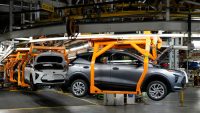It was meant to be the next big thing. Prompted by Tesla selling direct to customers, other car makers quickly jumped on the agency bandwagon.
Firms had been hoping to take more direct control over the sales process, bypassing traditional dealerships in favour of a more streamlined approach but despite much hype, the agency model has failed to yield the results many carmakers hoped for, in part because of a misunderstanding of the role of the traditional dealer.
Several automakers have scrapped agency plans, while others have had to adapt them. Cox Automotive has even dubbed the agency model a ‘false dawn’. So, what went wrong?
There are several factors why the agency sales model has faced difficulties in implementation and performance, from complex industry dynamics to customer behaviour and the entrenched knowledge and power of dealership networks.
A big reason why the agency model did not take off as expected is the disruption it can create in the long-standing relationship between manufacturers and dealerships.
For decades, dealerships have been the cornerstone of the automotive retail landscape, providing a well-established network for manufacturers to sell vehicles. The traditional dealership model involves the dealer purchasing cars from the manufacturer at wholesale prices and then selling them at retail prices to customers, making their profit through margins and service fees.
In contrast, the agency sales model involves the manufacturer taking on more control, dictating the prices and selling cars directly to customers, with dealerships acting more as facilitators or agents. Dealers earn a commission for the transaction but do not have the same level of autonomy or profit potential as in the traditional model.
This shift in roles created friction between manufacturers and dealers, many of whom have invested heavily in a physical presence, brand, and customer care. Not surprisingly, dealers have been resistant to losing their independence and profit potential.
The resulting disruption has led to slow uptake and pushback from dealer associations that have significant market power and knowledge – something manufacturers have seriously underestimated. This has been highlighted by several big brands scrapping their agency plans altogether.
Linked to this, the agency model failed to bridge the gap between what manufacturers hoped for and what customers really want from the car-buying process.
Automakers wrongly thought that the agency model would easily offer a more standardised, streamlined experience for customers, with transparent pricing, a stronger digital interface, and less of the haggling traditionally associated with dealerships.
This underestimated how sophisticated many customers actually are, with more nuanced preferences for buying cars than automakers realised. That nuance is something traditional dealers can cater to.
Let’s remember that for many consumers, purchasing a vehicle is one of the biggest financial decisions they make. They often value the personal touch, flexibility, and negotiation opportunities that traditional dealerships provide.
A significant chunk of car buyers actually enjoy visiting a dealership, kicking the tyres, taking the car for a spin, and working with sales staff to customize their purchase (including the finance deal).
Here, the physical presence of dealerships has offered a degree of comfort and support for buyers who want immediate post-sale services such as maintenance, repairs, and follow-up inquiries.
In an agency model, the perception of a purely transactional experience without these backups and touchpoints may put off customers who prefer a more hands-on approach to the car-buying process. After all, if you’re spending big money, you want a personal touch.
A big selling point of the agency model perceived by manufacturers is the idea of price standardisation. In the traditional dealership model, pricing can vary significantly based on location, dealer markups, and negotiation strategies.
By implementing the agency model, automakers hoped to provide consistent pricing across markets and remove the pressure on customers to haggle for the best deal. However, this strategy has not always worked.
Consumers are often used to the variability of pricing in the traditional dealership model, and many actively seek out opportunities to negotiate discounts, trade-ins, and special offers.
Manufacturers in this sense under estimated how sophisticated some customers are, especially when backed up with modern tech, information and apps like Auto Trader and Carwow which can help customers ease the hassle of negotiating with dealers.
In this regards, the agency model’s fixed pricing can feel rigid and unappealing to customers who are used to getting discounts and promotional deals. Some buyers may have even seen the agency fixed-price model as limiting their ability to save money.
An additional factor is that dealerships often play a significant role in facilitating local markets, offering incentives based on regional trends, and handling the financial aspects of deals, including trade-ins and financing.
Under the agency model, manufacturers assume greater responsibility for these elements, over which they often had little experience, thus adding to their costs and complexity without necessarily improving profitability.
The requirements needed for a successful agency model were also under estimated by manufacturers. The agency model requires a resilient digital infrastructure, as manufacturers need to manage pricing, customer relationships, inventory, and deliveries directly.
While many brands have made progress in improving their online sales platforms, there are still major gaps in integrating these systems with traditional dealer networks. The lack of seamless integration between online and offline channels creates friction for both customers and dealers.
A key lesson is that customer expect an omnichannel approach, and is usually helped by dealer input. Here, customers who start their purchase journey online don’t want to find the transition to the physical dealership experience disjointed. But dealers who are relegated to acting as mere agents may be disempowered from providing their usual high level of service and may not even be compensated for doing so.
The agency model can throw a spanner in the works of a smooth technological integration, further reducing its appeal for automakers and consumers alike.
Last but not least, a major roadblock to the agency sales model is the significant resistance from dealership networks themselves. Dealerships are deeply entrenched in the automotive ecosystem, and many have built their businesses on the traditional sales model that offers more control over inventory, pricing, and customer interactions.
Transitioning to an agency model can be seen as a threat to the livelihood of dealers and possibly their staff, which manufacturers ultimately need to sell cars.
In particular, the role of salespeople can become less defined in an agency model when they no longer have an incentive to ‘go the extra mile’ and close deals in the same way.
The demotivation and resistance from dealership staff can negatively affect customer experiences, leading to a lower overall performance of the model.
In essence, without the full buy-in of dealerships and their employees, the agency model can struggle to deliver the level of customer service that buyers expect.
Amidst all the hype over the Agency model, automakers failed to understand the key role that dealers play in enabling the market and helping customers navigate their way through complicated choices.
And as the choice of powertrain grows (think ICE, hybrid, electric) that role becomes even more pronounced. Having dealers on board may be even more important for automakers as the industry transitions into new technologies.
Article by David Bailey, professor of business economics at Birmingham Business School


































